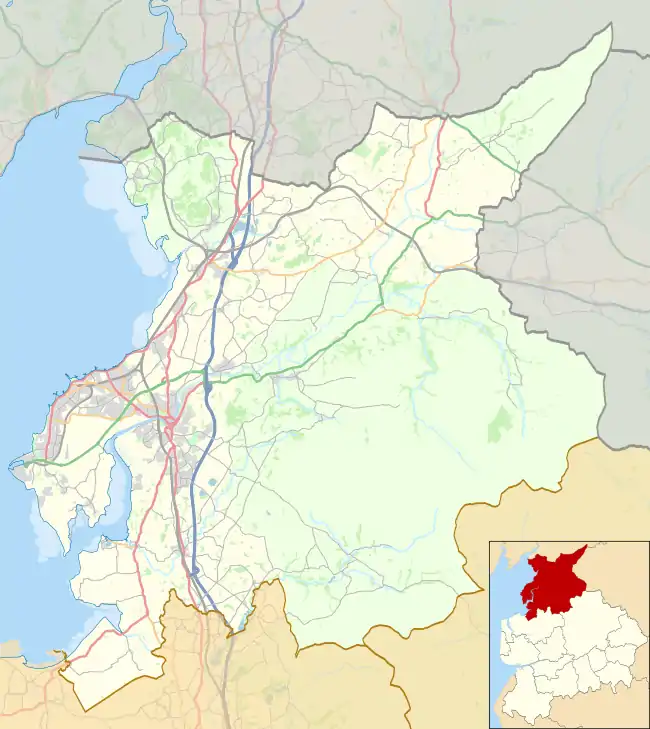St Margaret's Church, Hornby
St Margaret's Church is in Main Street, Hornby, Lancashire, England. The church is recorded in the National Heritage List for England as a designated Grade I listed building.[1] It is an active Anglican parish church in the diocese of Blackburn, the archdeaconry of Lancaster and the deanery of Tunstall. Its benefice is combined with those of St Michael, Whittington, St John, Arkholme, and St John, Gressingham.[2]
| St Margaret's Church, Hornby | |
|---|---|
 St Margaret's Church, Hornby, from the southeast | |
 St Margaret's Church, Hornby Location in the City of Lancaster district | |
| 54.1114°N 2.6362°W | |
| Location | Main Street, Hornby, Lancashire |
| Country | England |
| Denomination | Anglican |
| Website | Hornby, St Margaret |
| History | |
| Status | Parish church |
| Architecture | |
| Functional status | Active |
| Heritage designation | Grade I |
| Designated | 4 October 1967 |
| Architect(s) | Paley, Austin and Paley (restoration) |
| Architectural type | Church |
| Style | Gothic, Gothic Revival |
| Completed | 1889 |
| Specifications | |
| Capacity | 290 |
| Length | 93 feet (28 m) |
| Nave width | 38.5 feet (12 m) |
| Number of spires | 1 |
| Spire height | 66 feet (20 m) |
| Materials | Sandstone ashlar |
| Administration | |
| Province | York |
| Diocese | Blackburn |
| Archdeaconry | Lancaster |
| Deanery | Tunstall |
| Parish | Hornby with Claughton |
| Clergy | |
| Vicar(s) | Rev Lucie Lunn |
| Laity | |
| Reader(s) | Robin McIlveen |
| Churchwarden(s) | Liz Allison |
| Parish administrator | Martin Edmonds |
History
A church was on the site in 1338.[3]
The oldest part of the current church is the tower, which was built by Sir Edward Stanley, Lord Mounteagle, in 1514. Lord Mounteagle also arranged for the rebuilding of the chancel but this was incomplete when he died in 1524.
In 1817 the old nave was demolished and replaced by a new nave.[4] In 1888–89 a Victorian restoration was carried out by the Lancaster architects Paley, Austin and Paley. The nave was largely rebuilt, arcades and a clerestory were inserted, the church was reroofed and refloored, the west gallery was removed, the box pews were replaced by modern seating, the vestry was converted into an organ chamber, and a new vestry was built; this was done at an estimated cost of £3,000 (equivalent to £360,000 in 2021).[4][5][6]
A stained glass window from 1908 commemorates St Cecilia, gifted by survivors of William Henry Foster, as inscribed in the dedication. Unusually, it shows lady's slipper orchids (Cypripedium calceolus) at her feet.

Architecture
Exterior
The church is built in sandstone ashlar and its plan consists of a west tower, a nave and chancel under a continuous roof with a clearstory, and north and south aisles. The tower has three stages and is octagonal with the two upper stages being set diagonally to the base. Its parapet is embattled with pinnacles. The middle stage has a clock and a plaque carved with the Mounteagle arms. The nave and aisles have embattled parapets. At the east end is a semi-octagonal apse.[1]
Interior
In the church is a monument to Dr Lingard, the Roman Catholic priest from St Mary's Church, Hornby, who died in 1851. Also in the church are two fragments of Anglo-Saxon crosses.[7] The organ was built by Abbott and Smith and moved to St Margaret's from Hornby Castle in 1899. It was renovated by Ainscough around 1950 and restored by Harrison & Harrison in 1986.[8] There is a ring of eight bells. Six of these were cast by Abel Rudhall in 1761 and the other two by Mears and Stainbank of the Whitechapel Bell Foundry in 1922.[9] The parish register of baptisms begins in 1742 and that of burials in 1763.[4]
External features
In the churchyard is a sandstone Anglo-Saxon cross base which is listed at Grade II*.[10] The churchyard also contains the war grave of a Manchester Regiment officer of World War II.[11]
See also
References
- Historic England, "Church of St Margaret, Hornby (1071657)", National Heritage List for England, retrieved 9 June 2012
- Hornby, St Margaret, Church of England, retrieved 27 October 2008
- Hornby St Margaret, Diocese of Blackburn, retrieved 29 April 2008
- Farrer, William (1914), Brownbill, J. (ed.), Townships: Hornby, A History of the County of Lancaster, vol. 8, pp. 191–201, retrieved 29 April 2008
- Brandwood, Geoff; Austin, Tim; Hughes, John; Price, James (2012), The Architecture of Sharpe, Paley and Austin, Swindon: English Heritage, p. 237, ISBN 978-1-84802-049-8
- UK Retail Price Index inflation figures are based on data from Clark, Gregory (2017), "The Annual RPI and Average Earnings for Britain, 1209 to Present (New Series)", MeasuringWorth, retrieved 11 June 2022
- Hartwell, Clare; Pevsner, Nikolaus (2009) [1969], Lancashire: North, The Buildings of England, New Haven and London: Yale University Press, pp. 344–345, ISBN 978-0-300-12667-9
- "NPOR [D01796]", National Pipe Organ Register, British Institute of Organ Studies, retrieved 29 June 2020
- Information Sheet, Dove's Guide for Church Bell Ringers, retrieved 14 August 2008
- Historic England, "Cross base south of Church of St Margaret, Hornby (1071658)", National Heritage List for England, retrieved 9 June 2012
- LEVER, JAMES BERESFORD, Commonwealth War Graves Commission, retrieved 15 February 2013